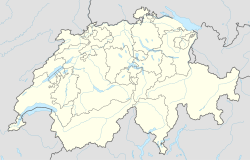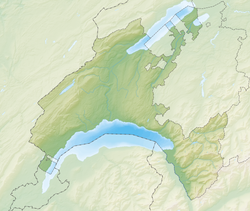Villars-Mendraz
| Villars-Mendraz | ||
|---|---|---|
| Former municipality of Switzerland | ||
|
||
| Coordinates: 46°39′N 6°44′E / 46.650°N 6.733°ECoordinates: 46°39′N 6°44′E / 46.650°N 6.733°E | ||
| Country | Switzerland | |
| Canton | Vaud | |
| District | Gros-de-Vaud | |
| Area | ||
| • Total | 1.55 km2 (0.60 sq mi) | |
| Elevation | 774 m (2,539 ft) | |
| Population | ||
| • Total | 183 | |
| • Density | 120/km2 (310/sq mi) | |
| Postal code | 1061 | |
| SFOS number | 5691 | |
| Surrounded by | Montaubion-Chardonney, Peney-le-Jorat, Sottens | |
| Website | Profile (French), SFSO statistics |
|
Villars-Mendraz is a municipality in the district Gros-de-Vaud in the canton of Vaud in Switzerland.
The municipalities of Villars-Tiercelin, Montaubion-Chardonney, Sottens, Villars-Mendraz and Peney-le-Jorat merged on 1 July 2011 into the new municipality of Jorat-Menthue.
Villars-Mendraz has an area, as of 2009[update], of 1.6 square kilometers (0.62 sq mi). Of this area, 1.13 km2 (0.44 sq mi) or 72.4% is used for agricultural purposes, while 0.31 km2 (0.12 sq mi) or 19.9% is forested. Of the rest of the land, 0.1 km2 (25 acres) or 6.4% is settled (buildings or roads).
Of the built up area, housing and buildings made up 3.8% and transportation infrastructure made up 1.9%. Out of the forested land, 17.3% of the total land area is heavily forested and 2.6% is covered with orchards or small clusters of trees. Of the agricultural land, 44.2% is used for growing crops and 27.6% is pastures.
The municipality was part of the Moudon District until it was dissolved on 31 August 2006, and Villars-Mendraz became part of the new district of Gros-de-Vaud.
The blazon of the municipal coat of arms is Per pale Gules, a Band wavy Argent and Vert, a Bend sinister wavy of the second, overall in chief a Pine tree eradicated Or.
Villars-Mendraz has a population (as of December 2009[update]) of 188. As of 2008[update], 7.4% of the population are resident foreign nationals. Over the last 10 years (1999–2009 ) the population has changed at a rate of 2.2%. It has changed at a rate of -1.6% due to migration and at a rate of 4.3% due to births and deaths.
...
Wikipedia




